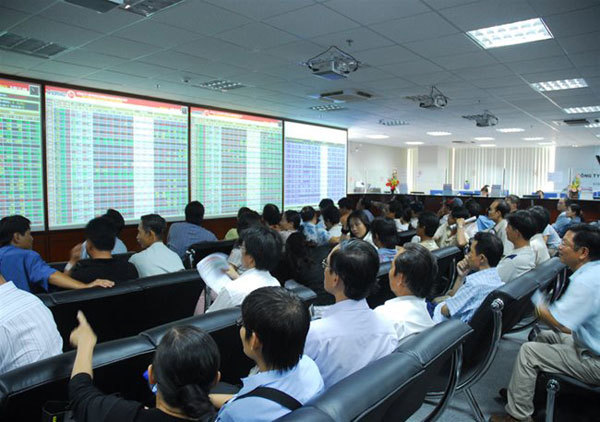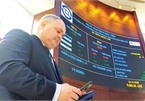What is the driver for the market confidence in 2021?
 |
| With the expectation that business activities in Vietnam will continue to improve in 2021 along with the global economic recovery, Vietnam’s stock market can hardly collapse as in 2008, and will experience only a downward correction and still maintain a bull trend over the medium term – Photo: Tran Ngoc Linh |
The market confidence is a major driver for the money flow into the stock market in 2020. The record increase in stock accounts of investors last year may signify a change in the habit from savings deposit, the traditional investment channel, to stock investment. Therefore, remarks about interest rates in the upcoming time will be important for assessing the attractiveness of investment channels.
There are two main reasons for the current low interest rate level. The first is the surplus liquidity in the banking system, which has dragged down the interest rate in the inter-bank market to a record low, with the one-month tenor at many times hovering around 0.15% per annum. The slow credit growth is the main reason for the low rate. The second reason is the monetary easing policy manifested through the reduction in policy rates. In addition, the State Bank of Vietnam (SBV) has continued to increase money supply through purchasing foreign currencies and selling the Vietnam dong in the foreign exchange market.
Credits increased again in late 2020. According to the SBV, as of December 21, outstanding loans had grown 10.14% against end-2019, a strong increase versus the growth of 5.12% by end-Q3. Credit growth in the entire 2020 was expected to reach 10.5-11%, not much lower compared with the growth of 12.1% in 2019. This is an impressive figure which shows more demand for lending.
The question is with the increase in the capital demand, does the interest rate rise enough to reverse the money flow from securities to bank deposits?
The increase in deposit rates will be inevitable if credits grow strongly and banks are short of funds. Then, the policy rates, including the ceiling rates for deposits and lending, will play an important role in the regulation of deposit rates in 2021. In other words, the target of the monetary policy in 2021 will dominate the commercial interest rates.
In reality, the United States has a great influence on not only macro-policies of Vietnam but also many other countries in the world. The moves of the Federal Reserve (Fed) are always watched globally and have a certain impact on the SBV’s action. Under the impact of the pandemic, the Fed has always shown its stance on keeping low target rates over a long time, along with maintaining quantitative easing packages to support economic growth. That said, the pressure for the SBV to increase the interest rate this year will ease and the bank can continue to maintain the policy rates at the current low levels to support economic recovery and growth.
Another factor is foreign capital flow is expected to increase strongly this year on the argument that Vietnam is a highlight in investment. The increased foreign currency supply will enable the SBV to buy more foreign currencies to beef up the foreign reserves as in 2020, which will come along with pumping more dong into the market. This will be the liquidity to reduce the capital pressure for commercial banks in case of strong credit growth.
To sum up, with the above logic, if the Fed continues monetary easing and keeps the target rates unchanged, foreign capital flow into the local market maintains stable growth and no financial shock as strong as that induced by Covid-19 occurs, the policy rates, including the ceiling rates for deposits and lending, this year may continue to be maintained at the current levels and will be the necessary caps to keep the deposit and lending rates low in case of strong credit growth. The low interest rates together with the expectation that the Covid-19 vaccine will speed up economic recovery early is the driver for money flow into the stock market in 2021.
Strong rally but hard to collapse
To clarify this viewpoint, it may need a comparison between the current market growth and the market in 2006-2007, the period before the global economic crisis. The common feature is the vertical market growth, which was expressive of a strong rally in a short time.
Both are the periods of gains from securities. However, they have different backgrounds. In the present time, the global economy seems to step out of a recession and Covid-19 fallout is only short term as assessed by many experts. The pandemic will gradually fade out when vaccines are available, and business activities and the global trade will be resumed. Meanwhile, the pre-2008 crisis was associated with the formation and development of the property bubble. With the expectation that business activities in Vietnam will continue to improve in 2021 along with the global economic recovery, Vietnam’s stock market can hardly collapse as in 2008, and will experience only a downward correction and still maintain a bull trend over the medium term.
Concerns still remain
Nevertheless, there remain many concerns over the market, not only in 2021 but possibly in the medium term. One of the concerns is the consequence of the Fed’s prolonged monetary easing. Massive money supplies have inflated the Fed’s balance sheet from over US$4.1 trillion in early 2020 to more than US$7.3 trillion on December 14, 2020, which is synonymous with the pumping of trillions of U.S. dollars into the market in 2020. Low interest rates and increased money supplies can weaken the dollar.
In recent times, many businesses have changed their strategies towards investment in Asia in place of the United States and the Eurozone as the interest rates there are too low. Japan’s biggest financial group MUFG has spent US$15 billion buying shares of credit institutions in Thailand, Vietnam, Indonesia and the Philippines. The group is also a major shareholder of VietinBank in Vietnam.
The capital withdrawal from low interest rate environments like the United States will weaken the U.S. dollar more, while massive money supplies will breed the expectation for hyperinflation of the dollar. This may kickstart a selloff of assets paid interest in U.S. dollar, which could send the dollar into hyperinflation though a flight from this global reserve currency is not likely. However, should such an event occur, it would be a crisis in the United States and its impact on Vietnam’s stock market would be visible.
Another risk is that low interest rates may start a property bubble in the United States, which already occurred after the dotcom crisis and led to the sub-prime loan crisis in 2008. The lending rate for home purchase in the United States is currently very low. According to statistics of Freddie Mac, the average lending rate for a 30-year loan with a fixed interest rate is down to only 2.6% per annum, the lowest in 50 years. The Fed’s stance on maintaining low interest rates can push property prices higher when home ownership is easy. The bubble can develop in a low interest rate environment and explode when the Fed raises interest rates again. The consequence of the financial crisis in 2008 remains a big lesson, as it impacted the global financial system and Vietnam’s stock market as well.
In the short term, however, Vietnam’s stock market still receives positive news. The rally in 2020 may continue well into 2021 with the hope for strong recovery of Vietnamese businesses. SGT
Pham Minh

New entity to invigorate Vietnam’s stock markets
With general optimism well-founded for Vietnam’s stock market building in the past year, there is now significant anticipation for 2021 with the arrival of a new entity to run the country’s exchanges.

First trading session of Vietnamese stock market in 2021 opens
The first trading session of Vietnam’s stock market in 2021 opened on January 4, with a gong-beating ceremony held by the State Securities Commission and the Hanoi Stock Exchange (HNX).